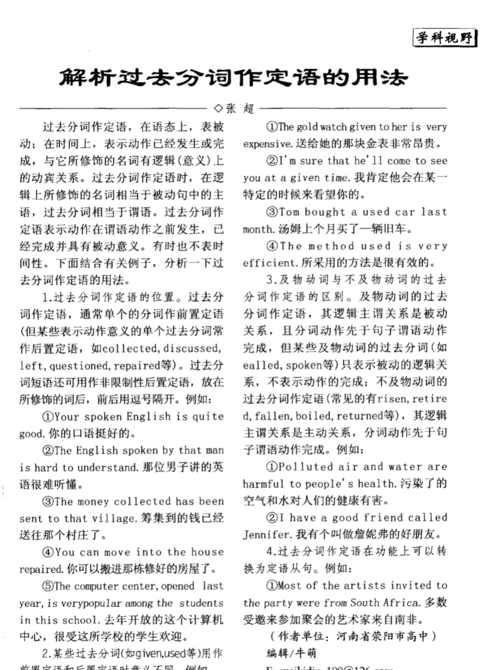本文目录
后置的定语从句中省略be动词
什么是英语的后置定语
定语的位置一般有两种:用在所修饰词之前的叫前置定语,用在所修饰词之后的叫后置定语。例:This is a very interesting book. 这是一本很有趣的书。一般情况下,修饰名词或代词的词多放在被修饰词之前,但在以下几种情况下,修饰名词或代词的定语却放在它们之后,这种定语我们称之为后置定语。
英语后置定语的讲解
一、形容词作疑问词的后置定语
修饰疑问词what, which, who, whose, whom, when, where, why, how时,修饰语要后置。例如:
1)What important would you like to talk about?你将谈论什么重量的事情?
2)Who else will go with us?还有谁将和我们一起去?
3)Where new have they decided to visit?他们决定到哪些没有去过的地方参观?
二、形容词作复合不定代词的后置定语
当被修饰词为复合不定代词something, anything, nothing, everything; somebody, anybody, nobody, everybody; someone, anyone, everyone, no one时,修饰语常位于被修饰的不定代词之后。例如:
1)I have something important to tell you.我有些重要的事情要告诉你。
2)Do you have anything else to say about it?关于这件事,你还有什么要说的吗?
3)Someone important will give the students a lecture on the current international situation this afternoon.今天下午,一位重要的人物将给学生们做一场有关当前国际形势的报告。
三、enough作后置定语
enough(a.)修饰名词时既可以在名词前,也可以在名词后。例如:
1)We have not enough time(or time enough)to do the job.我们没有足够的时间做该工作。
2)They have enough people(or people enough)to do the experiment.他们有足够多的人手做这个实验。
但enoush(odv.)修饰形容词或副词时,须位于被修饰的形容词或副词之后。例如:good enough (足够好的),large enough(够大的),fast enough(够快),well enough(相当好)。
四、部分副词作后置定语
above(上方的),below(下面的),on(活动,进行,上演),out(外出),back(后面的),away(离开的)等修饰名词时位于被修饰词之后。例如:
1)The clouds above began to get thicker,上方的云开始密集起来。
2)From the hill top we could see the plain below.从山顶上我们可以看到下面的平原。
3)She went to see them on the evening out.凡她晚上外出总去看他们。
五、介词短语作后置定语
the bird in the tree树上的'那只小鸟
the map on the wall墙上的地图
the development of China中国的发展
the standard of living生活水平
the south side of the Changjiang river长江两岸
the way to the hotel去旅馆的路
the life in the future未来的生活
六、动词不定式作后置定语
1.在某些名型结构中可用动词不定式作后置定语。例如:
1)I have tons of letters to answer.我有很多信要回。
2)She needed someone to take care of her baby.她需要人照看她的婴儿。
3)They were the first to bear hardships, the last to enjoy comforts.他们吃苦在前,享受在后。
4)He is a nice man to work with.他是个好相处的人。
5)There are a lot of things for us to be done.有许多事情要做。
6)There will be a very important person to come to our school this weekend.本周末有个重要人物来我们学校。
2.在某些名词后可用动词不定式作定语。例如:ability, anxiety, attempt, decision, chance, courage, right, determination, promise, ambition, drive, effort, eagerness, failure, inclination, intention, movement, need, opportunity, plan, reason, struggle, time, way, wish等等。例句:
1)Has he the ability to do the work?他有能力干这项工作吗?
2)I don't have the courage to tell you the secret.我没有勇气告诉你那个秘密。
3)You have no right to do such a thing!你没有做这样的事的权利!
4)I'll show you my determination to stop smoking.我将向你们表明我戒烟的决心。
3.动词不定式有时可以代替一个定语从句和后置定语。例如:
(1)Perhaps in the years to come(=that will come)we will meet again.也许在未来的岁月中我们还会再见面。
(2)In the lectures to follow(=that will follow), she talked of her trip to America.在后来的讲座中,她谈到了她的美国之行。
(3)She made a list of things to be taken(= which/that will be taken)on the way.她开了一张要带在路上用的物品清单。
另外,动词不定式还可以和关系代词which连用作定语:
1)She must have time in which to pack.她必须有时间收拾行李。
2)He also had a revolver with which to defend himself.他还有一把防身用的左轮枪。
3)He only had long night in which to study.他只有漫漫长夜可以用来学习。
七、分词短语作后置定语
1.现在分词短语作后置定语。例如:
1)There is a lady asking to see you.有位女士要求见你。
2)The girl sitting by my side is my cousin.坐在我旁边的是我表妹。
3)Here is a map showing you how to get to the railway station.这儿有一张地图,告诉你怎样去火车站。
2.过去分词短语作后置定语。例如:
1)What did you think of the play put on by the students?你认为学生们上演的话剧怎么样?
2)She is a nurse trained by ourselves.她是我们自己培养的护士。
3)What is the language spoken in svain?西班牙使用的是什么语言?
3.部分过去分词也可以作后置定语。例如:
left, gained, used, offered, discussed, ordered, wounded, injured, concerned, conducted, done, held, arranged, planned, suggested, finished, completed, arrested, given, fallen, constructed, missed,等等。例如:
1)Is there anybody injured?有人负伤吗?
2)The money left is not enough for so many people to live through.剩余的钱不够这么多人用的。
3)She liked all the courses offered.她对所开的课程都很喜欢。
4)The experience gained will be of great value to us.取得的经验将我们很有价值。
八、定语从句作后置定语
1)The girl I saw told me to come back today.
2)This house, for which he paid $ 150,000,is now worth $3000,000.这所房子他买时花了15万美元,现在值30万美元。
3)Sunday is a holiday, when people do not go to work.星期天是假日,这一天人们不上班。
学习、理解和掌握英语后置定语,并能够清楚地区分和使用各种后置定语的用法是十分重要的,对学习英语,理解英语文章

都是过去分词做好这件衣服和被动语态区别
过去分词作定语时,通常可替换某些定语从句.此时要注意两点:首先,在被替换的定语从句中,主语必须是作从句主语的关系代词;其次,定语从句中的谓语动词通常使用表示已经完成的时态或被动语态.如果是被动语态的话有be动词的,后置定语一般直接跟在要修饰的的名词后.e.g. a girl called lucy(定语)the apple tree has been cut down by people. (被动)过去分词做前置定语,是分词的形容词化,这个时候相当于形容词,比如 broken 就是break的过去分词,但是因为习惯把它当形容词用了,所以可以放在名词性的词之前 做前置定语但是这种情况仅限于 一些习惯用法过去分词做后置定语的情况要广泛得多,它其实是由被动语态的定语从句转化来的,如They saw some goods piled in that store.=They saw some goods which are piled in that store.你以后可能会见到更典型的句子。后置定语和被动语态是两个完全不同的概念,一个是句子成分,一个是句子语态。但是如果你这么问了,肯定是把过去分词作后置定语的情形和被动语态区分不开。被动语态,简单来说就是“be + 过去分词”(根据时态,前面的be形式也会改变)的结构,表示被动。(一般情况下是这样,但也有不带be动词的被动语态结构)e.g. The pen is bought by him.后置定语,很多成分都可作后置定于,基于你的问题,就说过去分词作后置定语的情况吧。这种情况通常是与被修饰的词是被动关系,才用过去分词。e.g. Children introduced to reading early develop strong verbal skills.

过去分词作定语的情况
定于有好几种,
1)可以是单词:She
is
a
pretty
girl.
里的pretty.
2)
短语:
I'd
like
something
to
eat.里的to
eat
3)从句:
I'd
like
something
that
I
can
eat.
里的that
I
can
eat.
单词作定语时,有过去分词、现在分词、形容词等等。
过去分词作定语,实际上多是省略了从句的主语和谓语动词,例如:
The
window
broken
has
been
repaired.
里的broken,是省略了从句:that
was
broken.
原句应该是:The
window
that
was
broken
has
been
repaired.

过去分词如何做后置定语
过去分词短语做后置定语,通常是过去分词带有副词或介词构成短语,少数时候带有逻辑主语的主语补足语。如:
1、The story well known to us all is Sima Guang.(过去分词前有副词,后有介词短语)
这个我们都知道的故事是关于司马光。
2、The book written by Lu Xun is taught in class.(过去分词后有介词短语)
课堂上讲鲁迅写的书。

扩展资料:
单个的过去分词一般只能做前置定语,很少做后置定语。但某些单个的过去分词可以做后置定语;过去分词带有副词或介词构成短语的往往需要后置。如:
1、The boats used are beautifully painted and decorated with flowers of all colors.
用过的船用多彩的花儿美丽地装饰绘画。
2、The boy called Tom is my brother.
那个叫汤姆的男孩是我弟弟。
以上就是关于过去分词作后置定语省略,后置的定语从句中省略be动词的全部内容,以及过去分词作后置定语省略 的相关内容,希望能够帮到您。
